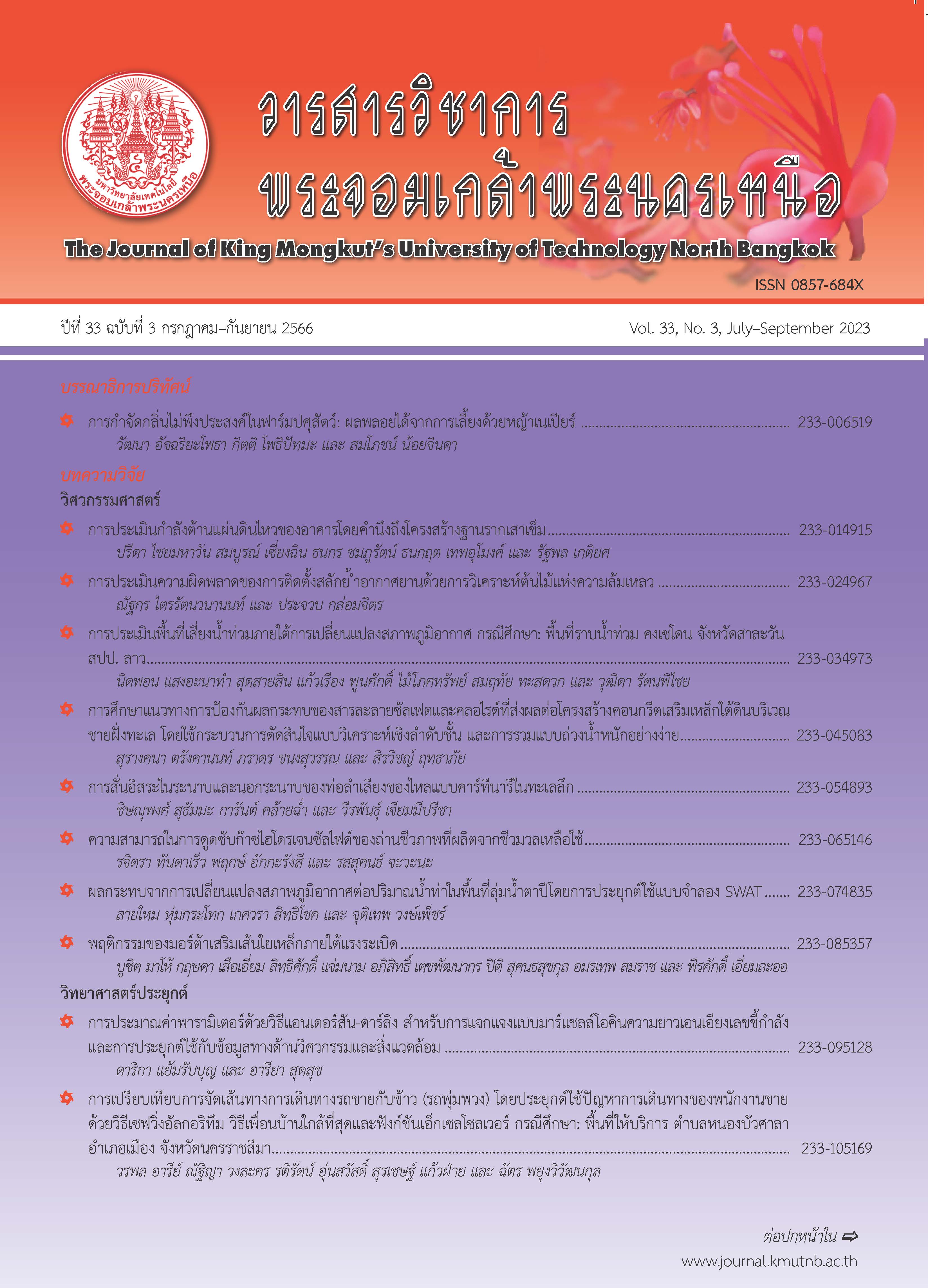Seismic Evaluation of Building Considering Pile Foundation
Main Article Content
Abstract
This article presents a comparative study of the evaluation results and responses of the building under seismic load using Phayao Province spectrum. The comparisons are made from the two different building models consisting of the model with the only super structure and the one with both super structure and pile foundation. The foundation model is constructed with frame elements and springs representing pile embedded in soil under lateral load. Based on the study results, the building model with pile foundation has higher natural frequency in fundamental mode shape and has different mode shapes and modal participation ratios compared with the building model without pile. The building model with pile tend to reduce the lateral stiffness but does not reduce the maximum lateral resistance. It was also assessed by the reduced seismic force and the lower level of damage was also found. The parametric study of the building model with pile foundation embedded in various types of soil indicated that, the model will significantly reduce seismic evaluation force, especially in case of soft soil but the model has more deformation. The building model should consider sub structure, especially in case of soft soil, in order to evaluate the seismic performance of the building properly.
Article Details

This work is licensed under a Creative Commons Attribution-NonCommercial-NoDerivatives 4.0 International License.
The articles published are the opinion of the author only. The author is responsible for any legal consequences. That may arise from that article.
References
J. Bielak, “Dynamic response of non-linear building-foundation systems,” Earthquake Engineering Structure Dynamic, vol. 6, pp. 17–30, 1978.
M. A. Ghannad and H. Jahankhah, “Sitedependent strength reduction factors for soil– structure systems,” Soil Dynamic Earthquake Engineering, vol. 27, no. 2, pp. 99–110, 2007.
M. Moghaddasi, M. Cubrinovski, J. G. Chase, S. Pampanin, and A. Carr, “Probabilistic evaluation of soil–foundation–structure interaction effects on seismic structural response,” Earthquake Engineering Structure Dynamic, vol. 40, pp. 135–154, 2011.
W. Sae-Long, S. Limkatanyu, C. Hansapinyo, T. Imjai, and M. Kwon, “Forced-based shearflexure- interaction frame element for nonlinear analysis of non-ductile reinforced concrete column,” Journal of Applied and Computation Mechanics, vol. 6, pp. 1151–1167, 2020.
W. Sae-Long, S. Limkatanyu, P. Panedpojaman, W. Prachasaree, N. Damrongwiriyanupap, M. Kwon and C. Hansapinyo, “Nonlinear winkler-based frame element with inclusion of shear-flexure interaction effect for analysis of non-ductile rc members on foundation,” Journal of Applied and Computation Mechanics, vol. 7, no. 1, pp. 148–164, 2021.
A. Pimanmas, P. Chaimahawan, and P. Joyklad. Advanced Reinforced Concrete Foundation Structure Design, Bangkok: Civil Engineering Consultant and Training Co. ltd., 2012 (in Thai).
M. T. Davisson, “Latetal load capacity of pile,” in 49th Annual Meeting of the Highway Research Board, Washington District of Columbia, United States, 1970, pp. 101–112.
K. Terzaghi, “Evaluation of coefficients of subgrade reaction,” Geotechnique, vol. 5, pp. 297–326, 1955.
Seismic Evaluation and Strengthening of Buildings and Structures, National Standard DPT-1303-57, 2014 (in Thai).
Seismic Resistant Design of Buildings and Structures, National Standard DPT-1301/ 1302-61, 2018 (in Thai).
P. Chaimahawan, P. Wongrat, and T. Chompoorat, “Seismic response spectrum curve created from site exploration in Phayao province,” Engineering Journal of Research and Development, vol. 28, no. 3, pp. 15–26, 2017 (in Thai).
P. Wongrat, A. Buakla, T. Chompoorat, and P. Chaimahawan, “Earthquake effect to liquefaction potential in Phayao province,” Research and Development, vol. 31, no. 4, pp. 87–99, 2020.
Applied Technology Council, Seismic Evaluation and Retrofit of Concrete Buildings, ATC-40 Report, Redwood City, California., 1996.

